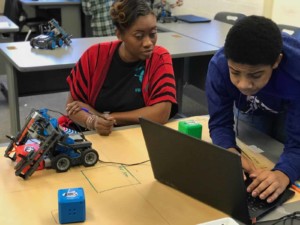Five Steps to Transforming a District

Transforming a district is simple. Simple in the way that a New Year’s resolution is simple – we know what to do and what is necessary, but successful long-term results depend on real change, including a change in mindset. Simple, yet difficult.
I recently wrote about the steps to transforming a school. I pointed out that by “transformation” I mean an environment where students are achieving academically and taking ownership of their learning: exhibiting agency. I listed four steps to achieving this transformation:
- Data-informed instruction;
- Student-centered approaches;
- Ongoing improvement/innovation processes;
- Every child known by a caring adult both academically and as a person.
This article is about the conditions that make that transformation possible. There are two possible approaches. The first requires the principal to take a courageous stand, taking the steps toward transformation in spite of a command-and-control culture that discourages innovation, penalizes productive failure, and values overly simplistic measures of success. The second is for the district itself to foster the transformation with five pragmatic practices:
- Understanding Why
- Setting Authentic Goals, Measures, and Expectations
- Aligning Leadership
- Fostering an Intrinsically Motivating Environment
- Communicating Transparently
Understanding Why
Transformation is the result of intentional practice on the part of all educators and administrators and it requires decision making that is aligned at every level without being controlled top-down. This means that everyone needs to have a deep and shared understanding of why transformation is important and what it looks like so they can make day-to-day small and large decisions that move schools toward that goal.
The“why” behind transformation needs to address a district’s vision of how to prepare students for a new and different environment for life, citizenship, and work. If every educator and administrator can explain this “why” in their own words and on their own terms, distributed leadership and decision making become possible.
This requires the hard work of deep, reflective conversations among all stakeholders about what they want for students and the best ways to get there. It involves bringing in research and case studies to get a sense of what works in other places. It is bottom-up work inside a top-down framework.
One of the best mechanisms for these conversations is the Personal Learning Community held frequently by school or grade level or department or among principals or district administrators. Ideally they will be held regularly at all levels and constantly ask the questions “What does better look like?” and “How do we get there?”
Over time the shared vision and the “why” diffuses through the district and become deeply ingrained in the culture at all levels.
Setting Authentic Goals, Measures, and Expectations
I say measures, not metrics, to emphasize that much of what is important to measure is not easily quantifiable – it requires the professional judgment of educators to determine whether things like agency, creativity, critical thinking, resilience, and collaboration are increasing among students. This is the opposite of traditional goal-setting.
It is important to measure outcomes that trade off against each other together. For instance, linking test scores and agency means that if higher test scores are achieved at the cost of student agency, or student agency is achieved at the cost of test scores, that is an unacceptable result. Insisting that both measures rise together keeps the system balanced and prevents a single measure from making it go “open loop.” It prevents a single metric from pushing out other valued outcomes.
When authentic measures and metrics are used in balance to get a complete picture of student and educator performance, educators are liberated to work in the best interest of their students. The work becomes more human and humane.
Additionally, clear expectations must be set for each school and department, and those measures must be aligned. For example, if schools are being asked to raise both agency and test scores, there cannot be conflicting requirements to follow a prescriptive pacing guide that doesn’t leave room for the student-centered instruction that can support that.
Aligning Leadership
Bringing district leaders and schools into alignment on vision, goals, measures, and expectations goes beyond buy-in to ownership. District leaders who are responsible for their own spheres (silos) of influence need to agree, in particular, about what things that used to be done are no longer needed. In a transformative environment, what processes and resources can be dropped?
Alignment means that schools are given missions that have structural integrity instead of conflicting requirements. Every district leader will give the same message about what new requirements are mandatory and which old requirements can be discarded.
This kind of ownership comes from a bottom-up process of reflective, thoughtful conversations at all levels. The top leadership sets the overall context by bringing in research and case studies regarding what kind of work environment students will graduate into and what kind of skills and dispositions will be needed to thrive in those environments. From there, goals can be set and research used to identify the best approaches for achieving those outcomes. Then it is a matter of deciding which practices and requirements support those approaches and which undermine them.
Fostering Intrinsically Motivating Work Environments
For breakthrough student performance, schools must be intrinsically motivating places of learning. For breakthrough teacher performance, schools must also be intrinsically motivating places of work. Intrinsic motivation is like engagement on steroids – it eliminates the friction of trying to drag people reluctantly through hoops and makes work feel like Papert’s “hard fun.”
The elements of intrinsic motivation are known: autonomy, mastery, and meaning. For more information, Dan Pink’s own summary of the research presented in his book, Drive, is an excellent resource.
But what it looks like in practice is an uncomfortable giving up of control and a conscious exercise of trust. District leaders must give up control (but not authority) to principals who must give up control to teachers who must give up control to students. This doesn’t mean removing all structure and guidance. Instead it challenges each person in the system to always question whether something they are controlling really needs to be controlled. Is it necessary to control the place each student goes on the Internet at all times, or is it enough to provide responsible use guidelines, for example. Once again authentic, collaborative, reflective practice is the key.
Communicating Transparently
Finally, a transformative environment requires constant, transparent over-communication. If leadership is to be distributed and decisions are to be made at the lowest level possible (as is necessary for an intrinsically motivating, high performance organization) everyone needs to know and be able to articulate not only goals and measures, but the current environment and the internal and external factors that affect it. Constant clear over-communication provides context, and context is critical for day-to-day decision making.
Putting it All Together
As simple as a New Year’s resolution. And as difficult. Where to start?
- Begin with Tony Wagner’s Seven Survival Skills and his book with Ted Dintersmith, Most Likely to Succeed (or watch the movie), to create a context about what students will need to know and do, then set goals.
- Look at Dan Pink’s book, Drive, then consider how to make the classroom and the workplace intrinsically motivating.
- Investigate student-centered approaches that support intrinsic motivation in the classroom.
- Set up PLC’s for grade levels and departments, principals and district administrators to craft carefully the goals and measures that will guide distributed leadership.
- Allow goals, measures, and alignment to “trickle up” within the context set by senior leadership.
- Constantly over-communicate (but don’t over burden) in order to provide a clear context for the whole district to operate under.
For more blogs by Marie, check out:
- Four Steps to Transforming a School
- Embedded Formative Assessment: Tests without Stress
- Elements of High Agency School Environments
Stay in-the-know with all things EdTech and innovations in learning by signing up to receive the weekly Smart Update.






Donna Sweet
Having lived through a school makeover I am in total agreement with the statement that it is like a New Year's resolution. All relevant.